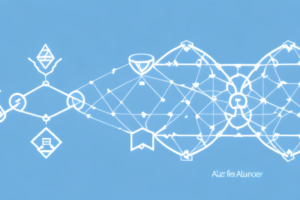Secure Access Service Edge (SASE) SDWAN Deployment vs Traditional SDWAN Deployment

Two networks
As businesses continue to migrate to the cloud, the demand for agile and secure network solutions has never been higher. The rise of software-defined wide area networking (SDWAN) has allowed organizations to create more efficient and cost-effective networks, but the emergence of Secure Access Service Edge (SASE) has begun to disrupt the industry. In this article, we will examine the differences between traditional SDWAN and SASE deployments and the key factors to consider when choosing between them.
Understanding the Basics of SDWAN Deployment
SDWAN is a technology that allows businesses to connect their remote offices and data centers over the internet using software instead of dedicated hardware infrastructure. This results in a more cost-effective solution that is easier to manage and can offer improved reliability by leveraging multiple internet connections. SDWAN is a popular choice for businesses that have multiple locations and prefer a more flexible deployment model.
One of the key benefits of SDWAN is its ability to prioritize traffic based on application needs. This means that critical applications, such as video conferencing or VoIP, can be given priority over less important traffic, such as email or web browsing. This ensures that important business functions are not disrupted by network congestion or bandwidth limitations.
Another advantage of SDWAN is its ability to provide greater visibility and control over network traffic. With traditional WAN solutions, it can be difficult to monitor and manage network traffic across multiple locations. SDWAN, on the other hand, provides a centralized management platform that allows IT teams to easily monitor and control network traffic, as well as troubleshoot any issues that arise.
What is SASE and How is it Different from Traditional SDWAN?
SASE is a newer technology that combines SDWAN with network security features like firewalls, secure web gateways, and Zero Trust Network Access (ZTNA). This approach converges networking and security into a unified architecture, making it easier to manage and more effective at blocking threats. SASE is designed for organizations that require more advanced security features and want a single solution to manage both their networking and security needs.
One of the key benefits of SASE is its ability to provide security and networking services from the cloud. This means that organizations can easily scale their infrastructure and services as needed, without having to worry about managing physical hardware. Additionally, SASE can help reduce costs by eliminating the need for multiple security and networking solutions, as everything is integrated into a single platform.
Another advantage of SASE is its ability to provide secure access to applications and data from anywhere, at any time. With more employees working remotely, it’s important to have a solution that can provide secure access to corporate resources without compromising on security. SASE achieves this by using a combination of identity-based access controls, encryption, and other security measures to ensure that only authorized users can access sensitive data and applications.
Benefits of SASE Deployment for Your Network Security
SASE offers several benefits for network security, including better visibility, improved performance, and centralized policy management. With SASE, businesses can monitor and manage their entire network from a single console, making it easier to spot potential threats and quickly respond to them. SASE also optimizes network traffic, improving performance and reducing latency, which can be especially important for businesses that rely on real-time applications like video conferencing.
Another benefit of SASE deployment is its ability to provide secure access to cloud applications and resources. With SASE, businesses can ensure that their employees can access cloud-based applications and data securely, regardless of their location or device. This is particularly important in today’s remote work environment, where employees may be accessing sensitive data from outside the office network.
Additionally, SASE can help businesses reduce costs associated with network security. By consolidating multiple security functions into a single platform, businesses can save money on hardware, software, and maintenance costs. SASE also allows businesses to scale their security needs as their network grows, without having to invest in additional hardware or software.
Advantages of Traditional SDWAN Deployment for Your Business
Traditional SDWAN has several advantages over SASE, including lower upfront costs and simpler deployment. With SDWAN, organizations can connect their remote offices and data centers quickly and easily using the internet instead of expensive dedicated lines. SDWAN deployments are also easier to manage, with minimal network maintenance required. This can be an attractive option for businesses that have limited IT resources.
In addition to the lower upfront costs and simpler deployment, traditional SDWAN also offers greater flexibility in terms of network customization. With SDWAN, businesses can choose the specific network providers and technologies that best suit their needs, rather than being limited to a single vendor or solution. This can result in a more tailored and cost-effective network solution.
Another advantage of traditional SDWAN is its ability to provide reliable and secure connectivity, even in areas with limited internet access. SDWAN solutions can leverage multiple internet connections, such as 4G LTE or satellite, to ensure uninterrupted connectivity. Additionally, SDWAN can provide advanced security features, such as encryption and firewall protection, to safeguard against cyber threats.
Factors to Consider When Choosing Between SASE and Traditional SDWAN
Choosing between SASE and traditional SDWAN depends on several factors, including your business needs, budget, and security requirements. If your organization requires advanced security features like Zero Trust Network Access (ZTNA) or you need to meet strict compliance regulations like HIPAA or PCI-DSS, then SASE may be the better option. On the other hand, if your organization has limited IT resources and prefers a more flexible and cost-effective networking solution, traditional SDWAN may be the way to go.
Another important factor to consider is the location of your workforce and applications. SASE is designed to provide secure access to cloud-based applications and remote workers, making it a great option for organizations with a distributed workforce. Traditional SDWAN, on the other hand, is better suited for organizations with a centralized workforce and applications hosted in a data center. It’s important to evaluate your organization’s specific needs and infrastructure before making a decision between SASE and traditional SDWAN.
Cost Comparison: SASE vs Traditional SDWAN Deployment
One significant factor to consider when choosing between SASE and traditional SDWAN is cost. While SASE offers a more comprehensive solution, it can be more expensive than traditional SDWAN. SASE requires more hardware and advanced security features that drive up costs versus SDWAN. Additionally, subscription-based pricing might be more expensive than that of traditional SDWAN providers.
However, it is important to note that SASE can also provide cost savings in the long run. With SASE, there is no need to purchase and maintain separate security appliances, as all security functions are integrated into the solution. This can result in lower operational costs and a reduction in the need for IT staff to manage multiple devices.
Another cost consideration is the scalability of the solution. SASE can be more easily scaled to meet the needs of growing businesses, as it is a cloud-based solution that can be easily expanded. Traditional SDWAN, on the other hand, may require additional hardware and infrastructure to be added, which can be costly and time-consuming.
Which Deployment Option is Best for Your Organization’s Needs?
Choosing the right deployment option depends on your business’s needs. If security is a top concern, then SASE may be the better option, particularly for those businesses that handle sensitive information or are in highly regulated industries. If cost is a significant concern or your organization has limited IT resources, then a traditional SDWAN solution may be best for you. Ultimately, each organization needs to evaluate its unique needs and requirements to determine which solution is right for them.
Evaluating the Performance and Scalability of SASE vs Traditional SDWAN
Another factor to consider between SASE and traditional SDWAN is the performance and scalability of the network. SASE provides more efficient routing for data traffic, as well as improved network security features and advanced analytics. Traditional SDWAN, on the other hand, allows for more granular traffic control, which can come in handy in data center deployments. Each solution has its advantages, and it is important to consider your organization’s specific requirements and use cases to determine which solution provides the best performance and scalability for your business.
The Future of Networking: How SASE is Changing the Game
As businesses continue to migrate to the cloud and rely more heavily on distributed workforces, the demand for agile and secure networking solutions will only continue to grow. SASE is an emerging technology that is poised to disrupt the industry by combining the networking and security solutions into a single, unified architecture. As more businesses adopt SASE and providers continue to innovate, it is clear that SASE will play a significant role in the future of networking.
Top Providers of Secure Access Service Edge (SASE) and Traditional SDWAN Solutions
Several providers offer SASE and traditional SDWAN solutions, each with varying features and pricing models. Some of the leading SASE providers include Cisco, Palo Alto Networks, and Zscaler, while traditional SDWAN providers include Silver Peak, VMware, and Fortinet. It is critical to compare the features of different providers and determine which solution is the best fit for your organization.
Real-World Examples: Success Stories from SASE and Traditional SDWAN Deployments
Businesses across various industries have already adopted both SASE and traditional SDWAN solutions successfully. For example, one notable case study features a tech startup that implemented SASE and was able to save over $20,000 annually on its connectivity costs while improving its network security capabilities. Another business deployed traditional SDWAN and was able to reduce the cost of its WAN by 80% while still improving network performance. These examples demonstrate the versatility and effectiveness of both SASE and traditional SDWAN solutions.
The Role of Cloud Computing in the Evolution of Networking
Finally, it is worth noting the significant impact of cloud computing on the evolution of networking. The rise of cloud-based applications and services has allowed for more distributed workforces and a shift away from traditional networking models. SASE and traditional SDWAN both rely on cloud infrastructure, making it easier for businesses to manage and deploy their networks. As cloud computing continues to evolve, it is likely that SASE and traditional SDWAN solutions will also evolve to keep pace with the changing landscape.
Addressing Security Concerns in Both SASE and Traditional SDWAN Deployments
Lastly, we must consider the importance of addressing security concerns in both SASE and traditional SDWAN deployments. While SASE offers more advanced security features out of the box, traditional SDWAN can also integrate with third-party security solutions to provide a comprehensive security posture. Businesses must address potential security concerns, regardless of the route they choose, and develop a security strategy that addresses both the network and application layer.
Comparing the User Experience: How SASE and Traditional SDWAN Impact End Users
Finally, one factor to consider when choosing between SASE and traditional SDWAN deployment is how they impact end-users. With SASE, end-users may experience improved network performance and a more secure experience, particularly remote workers who use Zero Trust Network Access (ZTNA). At the same time, with traditional SDWAN, end-users might experience better performance for everyday applications such as browsing and email. This trade-off is something businesses should consider for their specific use cases.
In conclusion, there are multiple factors to consider when choosing between SASE and traditional SDWAN deployment. Ultimately, each organization needs to evaluate its unique requirements, use cases, and budget to determine which solution is the best fit for them. With the rise of cloud computing and the continued evolution of networking, it is clear that both SASE and traditional SDWAN solutions will continue to play an essential role in the future of networking.



